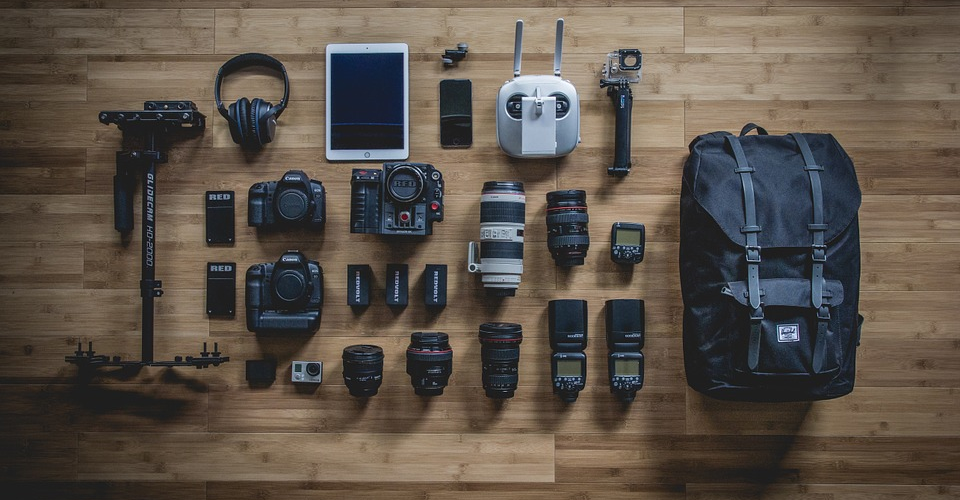Beginner’s Guide to the 8 Essential Camera Types
Smartphones are the best thing that could have happened to revitalize photography as a hobby and a vocation. It’s easier than ever for millions of people to document their precious moments and share them with others. However, using a phone merely gives you a taste of what standalone cameras are capable of and will only take you so far.
Phone cameras have small sensors, limit your freedom of experimentation, and become useless in unfavorable light. What’s the next step then? That’s an excellent question, but its answer isn’t straightforward. This article aims to help answer it by presenting you with the various camera types at your disposal. It covers what you can expect of every kind of camera as well as what their pros and cons are. We include a high-quality example for each and encourage you to check out our other articles if you need further recommendations.
1. DSLRs
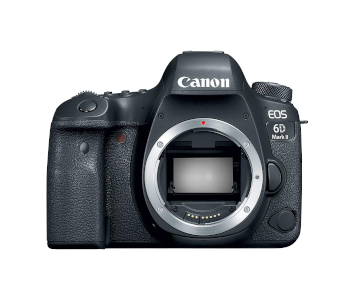
DSLRs are arguably the most versatile cameras capable of capturing breathtaking photographs of any type as well as cinema-grade videos. Serious enthusiasts and professionals prize them for their reliability, modular approach to photography, and the depth of options at your disposal. Even though mirrorless cameras are steadily closing the gap, DSLRs remain among the most respected and sought-after cameras today.
DSLR stands for digital single-lens reflex and refers to the way their viewfinder works. Each DSLR camera has either a prism or a series of mirrors which reflect light from the lens onto the optical viewfinder. The result is a supremely detailed live view with no lag. The downside to an optical viewfinder is that you see what the lens sees and can’t preview how aperture size, ISO, and other settings will affect the shot. Luckily, DSLRs have LCD screens you can use to set the shot up the way you like.
DSLRs are large and bulky cameras. They’re hard to lug around all day and may even take a toll on your neck & back muscles if you shoot with them for a living. On the other hand, their large frame lets manufacturers cram more features into them and develop expansive physical control schemes. Having dedicated dials and lots of customizable function buttons for settings you need to change frequently speeds up your workflow. DSLRs are ergonomic, and users with large hands can handle them confidently.
The size of a DSLR also has a bearing on the quality of its output. Larger models like the Canon EOS 6D Mark II have room for full-frame 35mm sensors which capture more light and perform better in low light. This lets you keep the ISO low while also reducing the noise generated by switching to higher values.
A wide selection of lenses is something DSLRs share with mirrorless cameras. Not relying on a fixed lens lets you shoot any scene by switching from one lens to another. You can capture everything from landscapes through portraits to scenes that are playing out miles away or nearly at the microscopic level. While some are ridiculously expensive, lenses once bought have the potential to stay current for decades as long as you’re upgrading to a model by the same manufacturer.
DSLRs are quick to power on and have speedy autofocus. This lets you turn the camera on and produce viable photos in a matter of seconds. A DSLR’s autofocus is adept at honing in on subjects and staying glued to them even under challenging conditions.
Finally, there’s battery life. DSLRs expend little power when framing a shot since digitization isn’t necessary to use the viewfinder. Their batteries regularly support an excess of 600 pictures per charge, allowing you to spend an entire day shooting without needing a replacement.
2. Mirrorless Cameras
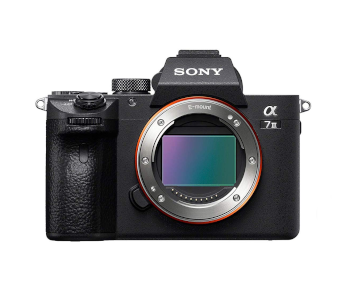
As their name suggests, mirrorless cameras lack a light reflex system and therefore have no optical viewfinders. Light travels through the lens and lands on the sensor instead. It’s then digitized and the data is sent to the camera’s LCD and electronic viewfinder or EVF. Mirrorless cameras are becoming increasingly more competitive across all price points. They produce smooth & stable footage when shooting video and make framing a shot easier than DSLRs.
Size and weight are a mirrorless camera’s most apparent advantage over DSLRs. They’re lighter and more compact, so you can use them longer without getting tired and store them in smaller bags. Mirrorless cameras are always lighter on average, whether you’re using a full-frame model like the Sony a7 III or one that has a micro four-thirds system such as the PANASONIC LUMIX G7.
No mirrors means less moving parts and mechanical noises, making mirrorless cameras both quieter and more stable. They have an advantage over DSLRs when it comes to stability, especially when shooting videos. Some mirrorless cameras have 5-axis image stabilization as well as stabilized lenses. Built-in image stabilization isn’t as advanced in DSLRs. It’s more likely they’ll capture shaky video if the attached lens lacks it as well.
Using an EV has both drawbacks and advantages. On the one hand, cheaper EVFs may not have 100% coverage of the sensor and their lower refresh rates mean you don’t see a live view of the subject. Mid- and top-tier mirrorless cameras don’t have this problem since their EVFs have better refresh rates. On the other, any changes you make to the camera’s settings are instantly reflected on the EVF. Since EVFs are digital displays, you can use them to zoom in, playback videos, and browse the picture gallery. It’s also possible to overlay the EVF with data such as focus peaking, zebra stripes, GPS, and more.
Mirrorless cameras offer more bang for your buck at low-and mid-level price points. They’re easier for beginners to pick up due to simpler control schemes. Many have an option to switch to simplified menus that explain settings and make it easier for newbies to get their bearings. The hybrid autofocus system in mirrorless cameras outperforms those present in DSLRs for less expensive models.
Lens selection for mirrorless cameras is smaller than for DSLRs. However, mirrorless lenses are easier to design. They’re more efficient at transferring light and cover the entire sensor. There are also more universal mirrorless lenses which you can attach to your camera thanks to conversion mounts.
3. Compact Cameras

The philosophy behind compact cameras can be summed up in three words – point and shoot. That’s actually what they’re sometimes referred to since using one is as simple as finding a subject and pressing the shutter button. Compact cameras aren’t as popular as they used to be since smartphone cameras give them a run for their money in many respects. However, a compact camera is the ideal inexpensive tool for people who want to graduate from taking pictures with their smartphone onto something more.
Compact cameras are the smallest and most portable kind of traditional camera. Some are slim enough to fit in your pants pocket while all of them take up little space in a bag. Compact cameras have fixed lenses which have a shallow profile when retracted and are less likely than standalone lenses to get damaged. Compact cameras are also extremely durable. Take the Olympus Tough TG-6, for example. It’s water-and dustproof, won’t buckle under 200 pounds of pressure, and can survive a nasty fall!
Beginners will find compact cameras easy to master. While some do offer semi-automatic and even manual controls, compacts are best-known for their numerous automatic presets. These let newbies quickly adapt the camera’s settings for any situation without having to understand anything about things like shutter speed and white balance.
When compared to smartphones, compact cameras have two distinct advantages. Their sensors are larger and capture more light, which translates into quality and low-light performance that lags behind more sophisticated cameras. Nevertheless, it’s better than what you’ll find even on photo-centric smartphones.
Zoom is another considerable advantage. Whereas smartphones only have digital zooming which degrades the image more with increased magnification, compact camera zooms are optical. You can find reasonably-priced compact cameras with 30x or even 40x zoom lenses whose quality is restricted only by the weather and how stable the camera is.
Buying a compact camera can be more challenging than a DSLR or mirrorless because there are more cons you need to weigh. Many models don’t have a viewfinder, for example. They also produce images of lower quality than more expensive cameras. Excellent point-and-shoots do exist, but be prepared to spend considerably more on them. Compacts are great for novices but don’t offer much opportunity to grow. Some lack manual options entirely while all are limited by the fixed lens.
4. Bridge Cameras

Bridge cameras or superzooms are a hybrid between compacts and DSLRs. They have the body of a DSLR while their photo & video capabilities align more closely with point-and-shoots. Why would you want to buy one? Bridge cameras are markedly less expensive than DSLRs yet able to create stunning photos.
You can expect a similar level of comfort and ergonomics to that of a DSLR. Conversely, bridge cameras are easier to handle and can be operated in pure point-and-shoot mode. They support manual mode too, which makes bride cameras great learning tools for developing your craft.
Unlike compacts, bridge cameras have electronic viewfinders that are keeping pace with those found on more traditional camera types. Smaller sensors mean bridge cameras will never reach the quality of the DSLRs they imitate. However, there are workarounds like offering lower max resolutions that only affect blown-up images but allow bridge camera sensors to improve their low-light performance. Some models, like the PANASONIC LUMIX FZ1000, also employ bigger 1-inch sensors for better results.
Bridge cameras are also called superzooms doe to their excellent zoom lenses. Even though they’re fixed, bridge camera lenses are versatile and suitable for different subjects.
5. Action Cameras
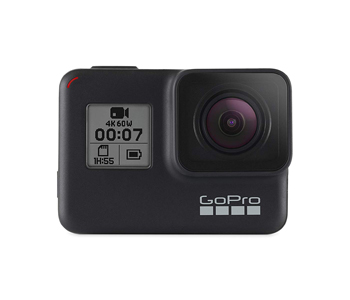
As the internet has exploded, so has the need for featherweight, durable cameras that can capture any moment as it unfolds. The first action cameras could only take photos, but they became increasingly more sophisticated as the technology matured and internet speeds increased. Today, action cameras focus mainly on producing video in remarkable detail but can nevertheless capture wonderful snaps from a unique perspective.
Action cameras are embodied in the GoPro HERO series. They’re waterproof, more portable than even the smallest compact, and can be attached to your body, car, or any other surface thanks to an assortment of accessories and mounts. Videos shot with action cameras have a wide field of view and produce a distinct fish-eye effect.
Ease of use is an action cam’s main selling point. Pushing the record button is all it takes to get incredible footage of whatever you’re doing. Voice commands and remote control via smartphone are equally popular. Manufacturers expect that you’ll use action cams to record extreme activities, which is why top-tier models feature exceptional image stabilization.
Action cameras are created with the connected person in mind. They make publishing content to social media and even streaming it effortless. On the other hand, you have access to powerful editing tools either on the cameras themselves or in their apps. These let you cobble together presentable videos from smaller snippets, add music, and perform basic color correction. You can then publish the finished creation online with a few swipes and taps.
The problem with action cameras is that they’re designed to excel in a specific set of situations while performing poorly in others. They’re practically unusable in low lighting and can’t create portraits or reporter-style logs without cropping the image. Low battery life is a notorious shortcoming all action cameras share. The best of them have enough juice for two hours of recording while the norm is 90 minutes or less.
6. 360-Degree Cameras

Also referred to as omnidirectional, 360-degree cameras capture panoramic shots in real-time. They have two 180-degree fish-eye lenses, one on each side of the camera. Their actual field of view is a bit wider so that some of the footage overlaps. This makes the seam that stitches them together appear less pronounced. Each lens has a dedicated sensor as well.
Two images are captured simultaneously and stitched together either by the camera or exported for you to put together in an editing program. The stitching process is less resource-intensive as there are only two pictures to combine. The result is also smoother than 360-degree shots taken with ordinary cameras. Since some cameras like the Insta360 One X have enough processing power to render 360-degree videos in real-time, you can stream these to a live audience.
The field of 360-degree photography and videomaking is relatively new and rapidly expanding. 360-degree photography is most widely used to create panoramic shots and to provide HDRI lighting maps for CGI. Videos created with a 360-degree camera are best experienced with virtual reality headsets and give the wearer a sense of complete immersion. Google Street View is the most popular practical application of 360-degree imaging technology. It provides a complete panoramic view of mapped streets and allows the user to take a virtual tour of many parts of the world.
The technology behind 360-degree cameras is still in the early stages of development and has many challenges to overcome. It’s much harder to frame a 360-degree scene because finding one with no distracting elements is more laborious. The person shooting the scene is also sometimes visible and needs to be removed in post. Even though they’re subtle, seams remain visible and might spoil the immersion. Finally, 360-degree videos need to be smoother than standard ones since shaking and unnatural movements can make your audience nauseous.
7. Camcorders
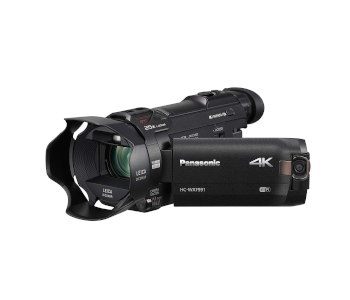
Camcorders have fallen out of favor as smartphones compete with budget models while mirrorless and DSLR cameras go head to head with pricier ones. Don’t discount them just yet, though!
Camcorders feature above average video quality which surpasses many competitors in the low- and medium-budget segments. They’re more portable than bulkier types and fit securely in your hand thanks to comfortable straps. Video is a camcorder’s primary focus, but their flip-out screens make it easy to frame a shot and take selfies too. Their design allows camcorders to have lenses on par with superzooms.
Audio is often poorly implemented on other camera types. While not perfect, the sound on camcorders is a grade above other cameras, and most camcorders have input jacks for external microphones and monitoring headphones.
We like the PANASONIC HC-WXF991K. It shoots 4K video, has 20x optical zoom extendable to 60x digital, and even sports onboard editing software to streamline your workflow.
8. Film Cameras

The last type of camera we’ll talk about is a dying breed. Film cameras are hard to find these days, but some do exist. Curiously, these occupy two ends of the spectrum. On the tail end, there are models like the Fujifilm Instax Mini 70. These let you snap photos which develop in minutes and are yours to keep. On the opposite end, you’ve got cameras that were once a professional’s pride and joy but can be had for cheap second-hand and are still capable of delivering amazing results.
So, why would you even want to consider film cameras seriously? Some hands-on experience with a film camera is beneficial to developing your skills as a photographer. The most important thing these cameras teach you is patience. Film is a limited resource, which forces you to think each time before you engage the shutter. You also need to consider how your shot is framed, the lighting conditions, and the film’s limitations carefully.
Film photography enjoys practical application in the art world. Photos shot with film cameras have a unique aesthetic, and the challenges associated with these cameras afford successful ones an air of prestige. Film sizes aren’t limited to 35mm, and some models take film four times as big or more. Photos shot with such cameras display a remarkable level of detail which isn’t lost when blowing them up into large prints.
Getting into film photography can be both satisfying and frustrating. You can’t see how your chosen settings will affect a photo. You have to choose which film you’ll use based on its ISO and have to purchase each roll. The cost grows steadily over time, even more so if you take many photos you’ll end up rejecting.

